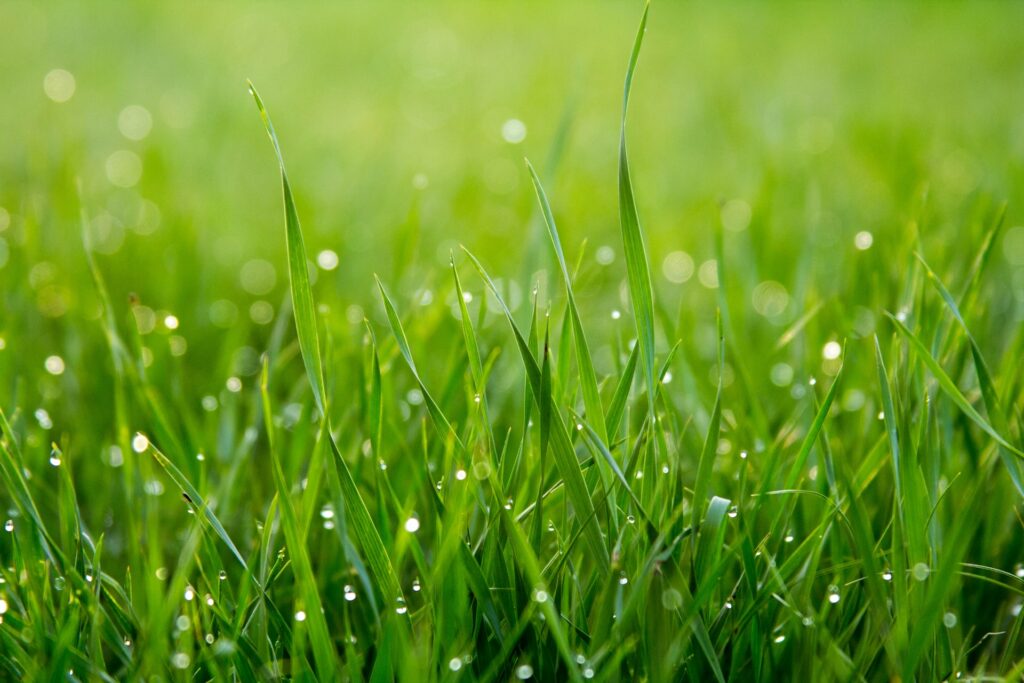If you’re like most homeowners, keeping your lawn looking green and healthy is a top priority. A well-fertilised lawn will not only look great, but it will also be resistant to weeds and pests.
This blog post will explain how to fertilise your lawn using both granular and liquid fertilisers. We’ll also provide tips on choosing the right fertiliser for your needs. So if you’re ready to get your lawn looking its best, keep reading!
What are the benefits of fertilising lawns?

Fertilising your lawn has many benefits, including:
1. Promoting growth:
The fertiliser provides the nutrients that grass needs to grow healthy and strong. It is essential in the spring and summer when the grass increases the most.
2. Preventing weeds:
A healthy, thick lawn is less likely to be invaded by weeds. Fertiliser helps to create a dense turf that crowds out weed seeds.
3. Feeding the soil:
Fertiliser not only benefits grass, but it also helps to improve the quality of the soil itself. It can lead to a healthier lawn in the long term.
4. Enhancing colour:
A well-fertilised lawn will be a more vibrant green than one that isn’t fertilised regularly. It is due to the extra nutrients available for the grass to use.
5. Improving stress tolerance:
Grass properly fertilised will be better able to withstand drought and other environmental stresses such as heat and cold snaps.
How to Fertilise Your Lawn:
A healthy lawn requires regular fertilisation to maintain its green colour and dense growth.
While many different types of fertilisers are available, the best way to fertilise a lawn is to use a slow-release fertiliser that will provide nutrients over an extended period.
Slow-release fertilisers are available in granular or liquid form and can be applied using a spreader, hose-end applicator or an even better option would be an EZ-FLO injection system that can be used to spread fertiliser using your hose or sprinkler.
Before applying fertiliser, it is essential to test the soil to determine its nutrient needs. Once the fertiliser has been applied, it is necessary to water the lawn deeply and evenly to help the nutrients reach the roots.
Proper care and fertilisation make a lawn a beautiful and low-maintenance addition to any home.
What are the best methods for fertilising lawns?

Anyone who has ever tried to grow a lawn knows that creating and maintaining a healthy grassy lawn is not always easy.
One of the most important aspects of keeping a lawn healthy is providing it with the proper nutrients, which can be done through fertilisation.
But with so many different fertilisers on the market, it can be challenging to know which one is best for your lawn. Here are a few things to keep in mind when choosing a fertiliser for your property:
The type of grass you are growing:
Different grasses have different nutrient needs, so be sure to choose a fertiliser specifically formulated for the kind of grass you are growing.
The time of year:
The needs of your lawn will change throughout the year, so choosing a fertiliser that is appropriate for the season is essential. For example, during the spring and summer months, your lawn will need more nitrogen for growth, while during the fall and winter months, it will need more phosphorus for root development.
The size of your lawn:
The amount of fertiliser you will need will vary depending on the size of your lawn. Be sure to follow the manufacturer’s recommendations to avoid over or under-fertilising.
By following these guidelines, you can be sure to choose a fertiliser that will help keep your lawn healthy and green all year long.

So, now that you know how to choose the right fertiliser, let’s dive into the different methods.
Slow-Release Lawn Fertiliser
Slow-release lawn fertilisers are an essential part of maintaining a healthy lawn.
Unlike traditional fertilisers, which release their nutrients all at once, slow-release fertilisers release their nutrients slowly over time.
It provides a steadier supply of nutrients for the grass, which helps to promote consistent growth and prevent brown patches.
In addition, slow-release fertilisers are less likely to burn the grass and are safer for pets and children.
For best results, choose a slow-release lawn fertiliser that is appropriate for your grass type.
Some common slow-release fertilisers include urea-based fertilisers, sulphur-coated urea fertilisers, and polymer-coated urea fertilisers.
How to use:
1. Read the manufacturer’s instructions carefully before using any fertiliser product.
2. Apply a slow-release fertiliser to your lawn in early spring before the grass begins actively growing for the season.
3. Use a broadcast spreader to apply the fertiliser evenly over the entire lawn area, following the manufacturer’s recommended application rate.
4. Water the area thoroughly after applying the fertiliser to begin working its way into the soil and root zone of the grass plants.
5. Or for an even better method that does not require using a broadcaster spreader and then watering. You could use the EZ-FLO injection system where you can spread the fertiliser using your garden hose or spinnaker system.
Organic Lawn Fertiliser
Organic lawn fertilisers are a great way to maintain a healthy lawn without harsh chemicals.
They work by releasing nutrients into the soil that help to promote healthy grass growth.
It can include everything from phosphorous and nitrogen to potassium and magnesium.
In addition, organic lawn fertilisers often contain beneficial microbes that help to break down organic matter and improve soil health.
As a result, they can give your lawn the extra boost it needs to stay green and vigorous. When applied regularly, organic lawn fertilisers can help you achieve a lush, healthy lawn that is safe for people and pets.
How to use:
To apply organic fertiliser, spread it over your lawn according to the manufacturer’s instructions. Be sure to water the fertiliser well so it can reach the roots of the grass.
Liquid Lawn Fertiliser
Liquid lawn fertiliser is a quick and efficient way to give your lawn the nutrients it needs to stay green and healthy.
Unlike granular fertilisers, liquid fertiliser is immediately absorbed by the grass so that you can see results within days.
Liquid fertiliser is also less likely to burn your grass, so you can apply it more frequently without fear of damaging your lawn.
Plus, liquid fertiliser is easy to apply – simply hook up a hose-end sprayer, and you’re ready to go or you can go for an even simpler method by using the EZ-FLO injection system that can be used to spread fertiliser using your hose or sprinkler.
When used as directed, liquid lawn fertiliser is an excellent way to keep your lawn looking its best.
How to use:
1. Read the label carefully before purchasing and follow the directions for your particular lawn fertiliser product.
2. Most liquid fertilisers are best applied using a hose-end sprayer, which allows you to mix the product with water and then apply it directly to your lawn without having to measure or mix anything yourself.
3. Be sure to wet your lawn thoroughly before applying the fertiliser. It will help prevent any burning or scorching of the grass from the concentrated chemicals in the fertiliser solution.
4. Apply the fertiliser evenly over the entire lawn, not missing any spots.
5. Water your lawn thoroughly after applying the fertiliser. It will help it absorb the roots more effectively and prevent any runoff onto sidewalks or driveways where it can cause staining or other damage.
Granular Lawn Fertiliser
Granular lawn fertiliser is a popular choice for gardeners looking to give their lawn a nutrient boost.
Made from a range of natural and synthetic ingredients, granular fertilisers are easily spread over the lawn and quickly absorbed by the grass.
However, they can also harm the environment if not used correctly. Over-fertilisation can lead to runoff, which can pollute waterways and harm wildlife.
Therefore, it is essential to follow the manufacturer’s instructions when using granular fertiliser and only apply it to healthy lawns that can absorb nutrients.
Used correctly, granular fertiliser can be an effective way to give your lawn a green and healthy boost.
How to use it:
Granular lawn fertiliser is easy to apply. You can spread it over your lawn with a spreader. Following the directions on the package is essential, so you don’t use too much or too little.
The different types of fertiliser for lawns:
- Nitrogen-based fertilisers:
These are the most common type of fertiliser used on lawns. They help to promote the growth and greening of the grass.
- Phosphorus-based fertilisers:
These are used to encourage strong root growth and help the grass to withstand drought conditions better.
- Potassium-based fertilisers:
These help the grass resist disease and pests and improve its overall health.
How often to use each type:
1. Nitrogen-based fertilisers: Every 4-6 weeks during the growing season (spring/summer).
2. Phosphorus-based fertilisers: Every 6-8 weeks during the growing season (spring/summer).
3. Potassium-based fertilisers: Every 8-10 weeks during the growing season (spring/summer).
What are the signs that your lawn needs fertilising?
A well-fertilised lawn is lush, green and healthy. However, over time, the soil’s nutrients can deplete, causing the grass to thin and turn yellow. If your lawn shows signs of stress, it may be time to fertilise. Here are some key indicators that your property needs a nutrient boost:
* The grass is thin and patchy. It could be a sign that the soil is lacking essential nutrients.
* The grass is discoloured. If your lawn has brown or yellow grass patches, it could indicate that the soil is too acidic or alkaline. Applying fertiliser can help to correct the pH balance and encourage new growth.
* The grass isn’t growing as quickly as it used to. If your lawn grows more slowly than usual, it could be due to a lack of nitrogen. Fertilisers can help to promote fast growth and restore the lawn to its former glory.
What are the common mistakes people make when fertilising lawns?
Applying too much fertiliser
Applying too much fertiliser is a common mistake when maintaining a healthy lawn.
While it may seem logical to apply more fertiliser if the grass looks unhealthy, this can do more harm than good.
Over-fertilisation can lead to nutrient burn, where the grass turns yellow or brown from being exposed to too many nutrients.
It can also encourage excessive growth, leading to weak and spindly grass that is more susceptible to disease.
Furthermore, Over-fertilised lawns are more likely to develop thatch, a layer of dead grass and organic matter that builds up over time and can prevent water and nutrients from reaching the grassroots.
As a result, it is essential to follow the manufactures instructions carefully and only apply fertiliser as needed. You can keep your lawn looking green and healthy all year round with a bit of care and attention.
Applying fertiliser to Wet Grass
Applying fertiliser to wet grass is one of the most common mistakes people make when trying to maintain a healthy lawn.
Not only does it waste fertiliser, but it can also damage the blades of grass.
The best time to apply fertiliser is early in the morning before the sun has a chance to evaporate the moisture.
It will give the fertiliser time to seep deep into the soil, where it can do the most good.
Not applying enough water after applying fertiliser
One of the most common mistakes people make when fertilising lawns is not applying enough water afterwards. It can cause the fertiliser to burn the grass, turning it yellow and leaving brown patches.
What are some tips for fertilising lawns?
Fertilising lawns is an integral part of keeping them healthy and green. However, there are a few things to remember if you want the best results. Here are some tips for fertilising lawns:
1. Test the soil before applying fertiliser. It will help you to determine which nutrients are lacking and how much fertiliser to apply.
2. Follow the manufacturer’s instructions carefully. It will ensure that you apply the right amount of fertiliser and avoid damaging the lawn.
3. Water the lawn after applying fertiliser. It will help to wash away any excess fertiliser and prevent it from burning the grass.
4. Mow the lawn after fertilising. It will prevent the mower’s newly-grown grass blades from being cut off.
Frequently Asked Questions:
How often should I fertilise my lawn?
It depends on the type of grass and the time of year. In general, cool-season grasses should be fertilised in early spring and late fall, while warm-season grasses should be fertilised in late spring and early summer. However, it’s always best to follow the manufacturer’s instructions.
Is it better to fertilise in the spring or autumn?
It depends on the type of grass. In general, cool-season grasses should be fertilised in early spring and late fall, while warm-season grasses should be fertilised in late spring and early summer. However, it’s always best to follow the manufacturer’s instructions.
Can I fertilise my lawn with manure?
It depends on the type of manure. Some types of manure can fertilise lawns, but others can damage the grass. It’s always best to check with the manufacturer or a lawn care expert before using manure on your property.
The Bottom Line:
Lawn fertilising is an important part of lawn care, and you must use the correct type of fertiliser for your specific grass type.
In this quick guide, we’ve outlined the basics of fertilising a lawn and which types of fertiliser are there. So, what are you waiting for your dream lawn is only one sprinkle away.
